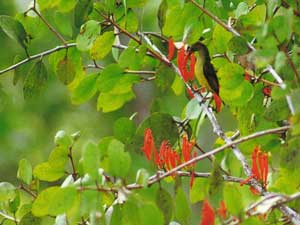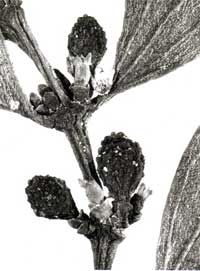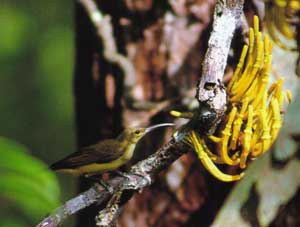Mistletoes - evolution
Floral evolution: pollination mechanisms
The flowers in Loranthaceae and Viscaceae are very different, although they do have some features in common. In the Viscaceae the flowers are small (mostly less than 2 mm long), usually green, and inconspicuous (right). They do not have distinct sepals and petals, instead only a single whorl of 2-4 triangular tepals. The 2-4 stamens are opposite the tepals, sometimes fused to them and sometimes to each other. The flowers are unisexual; in Australian Viscaceae the plants are monoecious, that is, with both male and female flowers on the one plant, but some non-Australian Viscaceae are dioecious, with separate male and female plants (see section on evolution of dioecy in Viscum). The pollen grains are spherical, relatively few in each stamen, and show no adaptations for wind dispersal. The tepals open to present a tiny cup-shaped flower at maturity, and there can be little doubt that pollination is by the small insects which visit the flowers.
In contrast, the flowers in Loranthaceae are often large to very large, and often brightly coloured (see illustrated checklist of Australian species). There are two whorls of perianth (sepals and petals), but the outer sepal whorl is reduced to a membranous rim, sometimes toothed, usually about 1 mm high, surrounding the petals at their base. Thus the distinct, attractive organs of the flower are the petals, in a single whorl of 4-8. Like the Viscaceae, there is one stamen opposite each petal. Its filament is fused along the inner surface of the petal for some distance before becoming free and presenting the anther. The pollen grains are mostly 3-lobed (rarely triangular or spherical). In Loranthaceae the flowers are mostly hermaphrodite (always so in Australia), and in those non-Australian genera which have functionally unisexual flowers the vestigial organs of the other sex are often still visible.
There are two distinct flower types in Loranthaceae, depending on whether the petals are free at maturity, or fused into a tube. When the petals are free they often spread widely when the flower opens. When the petals form a tube it is often narrow, trumpet-shaped, and curved.
In those loranths which appear to be primitive on other grounds (i.e., haustorial structure, chromosome number, embryology, geography) the petals are free, usually relatively short, and widely spread, giving the flower a dish-like appearance. They are often pale or inconspicuous in colour. They are clearly adapted for insect pollination, and it appears, therefore, that insect pollination represents the primitive mechanism for the Loranthaceae. Insect pollination has been retained in some derived genera, especially in South America, and there seem to be other cases in southeast Asia where there has been a reversal to insect pollination in derived genera.
 Amylotheca duthieana with red flowers, with Spiderhunter bird, Arachnothera. (click to enlarge) |
When the petals are fused into a tube the flowers are often brightly coloured, mostly in shades of red or orange, and often with bands of contrasting colour. These flowers show all of the usual adaptations for bird pollination, and it seems that there have been several parallel adaptive shifts in loranths from insect to bird pollination. Even in some species with free petals the petals tend to cohere at their margins at floral maturity, presenting as a tube, and are pollinated by birds. This is a common situation in Australia’s largest genus, Amyema ![]() , where many species are visited by a guild of honeyeaters.
, where many species are visited by a guild of honeyeaters.
There are a few cases in Loranthaceae where floral tubes have reached exceptional lengths, up to 150 mm long. No birds could reach the nectaries at the base of these flowers, and it has been suggested that they are pollinated by long-tongued moths. However in these flowers the anthers and stigma are still physically close, and birds or insects foraging for pollen may also effect pollination.
In their long history since Gondwanan times, loranths have made many shifts from original insect pollination to bird pollination, and sometimes back again, presumably depending on availability and seasonality of pollinators.
![An Australian Government Initiative [logo]](/images/austgovt_brown_90px.gif)



